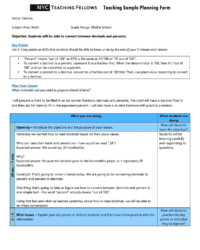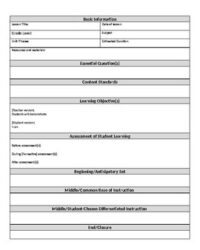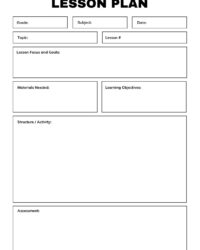Have you ever found yourself sifting through countless pre-made lesson plan templates online, trying to find one that perfectly fits your unique teaching style, your students’ needs, and your curriculum’s quirks? It can be a frustrating and time-consuming process, often leading to compromises that don’t quite hit the mark. Every educator knows the feeling of having a brilliant lesson idea, only to struggle with fitting it into a rigid, one-size-fits-all format.
What if there was a better way? Imagine a world where your lesson planning is streamlined, intuitive, and perfectly aligned with how you teach. The secret isn’t to keep searching for the mythical perfect template; it’s to create it yourself. Learning to make your own lesson plan template empowers you to design a planning tool that genuinely serves your needs, bringing clarity, consistency, and a whole lot less stress to your daily routine.
The Unbeatable Benefits of Crafting Your Personalized Lesson Plan Template
Taking the time to design your own lesson plan template might seem like an extra task initially, but it quickly pays dividends in efficiency, organization, and peace of mind. Think about it: every teacher has a unique way of thinking, preparing, and delivering content. A generic template simply can’t capture that nuanced approach. By building your own, you’re not just filling out a form; you’re developing a system that speaks your teaching language. This customization ensures that every element you deem essential for a successful lesson is right there, exactly where you need it, every single time. It’s about optimizing your workflow, not just for today’s lesson, but for every lesson you’ll ever teach.
A custom template also fosters consistency in your planning, which is invaluable. When you use the same structure for every lesson, it becomes second nature to fill in the necessary details. This predictability helps you identify gaps in your planning more easily and ensures you don’t overlook critical steps, like differentiation strategies or assessment methods. This consistency also benefits your students, as a well-planned, consistent approach to learning experiences helps them anticipate and engage more effectively with the material.
Tailored to Your Teaching Style
No two teachers are alike, and neither are their teaching methods. Whether you’re a project-based learning enthusiast, a flipped classroom pioneer, or a traditional lecturer, your template can reflect your preferred pedagogical approaches. You can include specific sections for group activities, technology integration, discussion prompts, or even quick notes for spontaneous teachable moments. This personalization ensures that your planning document genuinely supports how you envision and execute your lessons.
Streamlined Workflow
One of the biggest advantages of a personalized template is the significant time saving in the long run. Once you make your own lesson plan template, you eliminate the constant decision-making about what to include and where. All your essential categories are pre-set. This means less cognitive load during the planning phase, allowing you to focus more on the creative and instructional aspects of your lesson and less on the administrative task of organizing your thoughts onto paper or screen. It’s about working smarter, not just harder, in your preparation.
Essential Components to Include When You Make Your Own Lesson Plan Template
When embarking on the journey to design your perfect lesson plan template, consider what truly makes a lesson successful for you and your students. While there’s no single perfect template for everyone, certain core elements are widely recognized as crucial for effective planning. These components provide a clear roadmap for your instruction, ensuring you cover all necessary bases and deliver a coherent and engaging learning experience. It’s about creating a framework that supports both your teaching goals and your students’ learning journeys.
Begin by thinking about the logistical details that set the stage for your lesson. This includes obvious elements like the date, subject, grade level, and the specific unit or topic being covered. Beyond these basics, delve into the core of your instructional design. What do you want your students to know, understand, or be able to do by the end of the lesson? How will you get them there, and how will you know if they’ve succeeded? Crafting sections for these answers will form the backbone of your template.
Remember, the goal is to create a template that is comprehensive yet concise. It should be a tool that simplifies, not complicates, your planning process. Include only the sections that are truly valuable to your instruction. Don’t be afraid to iterate and refine your template over time; as you use it, you’ll discover what works best and what might need tweaking.
- Learning Objectives Clear, measurable statements of what students should achieve.
- Materials Required A list of all necessary resources, from textbooks to art supplies to digital tools.
- Lesson Procedure A step-by-step outline of activities, including introduction, direct instruction, guided practice, and independent work.
- Assessment Strategies How you will check for understanding and measure student learning, both formative and summative.
- Differentiation and Accommodations Plans for supporting diverse learners, including extensions for advanced students and modifications for those needing extra help.
- Homework or Follow-up Activities Any assignments or next steps for students to complete outside of class.
Taking the initiative to design a custom lesson plan template is a powerful step towards more effective and enjoyable teaching. It transforms what can often feel like a bureaucratic chore into a dynamic process that truly supports your instructional goals. By personalizing your planning, you create a tool that not only saves you precious time but also enhances the quality and impact of your lessons, leaving you more energy to focus on what truly matters: engaging and inspiring your students.
Ultimately, your personalized template will become an indispensable asset in your teaching toolkit, evolving with your professional growth and adapting to the ever-changing needs of your classroom. It’s an investment in your own efficiency and a commitment to delivering the best possible learning experiences.


